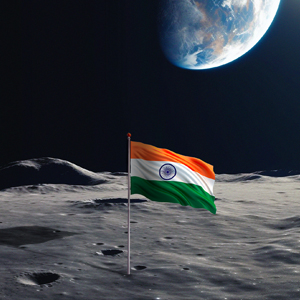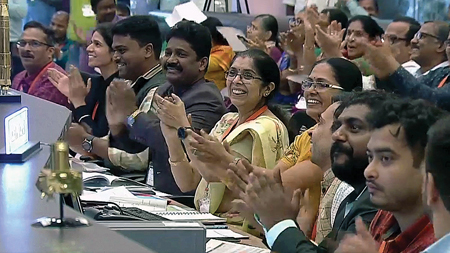Commentary: Over the Moon!

More than a month after the historic achievement, assessing what India’s moon landing means in reference to its place in the community of nations.
On August 23, one week after India celebrated its 76th Independence Day, the world witnessed a remarkable human achievement when India successfully landed a spacecraft on the moon.
As Indians who came of age witnessing the birth of a free India, we were fully cognizant that we belonged to an infant nation which was seeking its place under the sun. This maiden breakthrough landing on the moon’s untouched southern surface has catapulted India’s image to new heights—much more so than even its rising ascent in recent years as an IT and economic giant.
India now joins the United States, the Soviet Union, and China in the elite club of nations that have made it to the moon. A gushing nation acted as one in celebrating India’s unprecedented achievement even as an exuberant prime minister, who was overseas, proudly exclaimed, “This moment is unforgettable. It is phenomenal. This is a victory cry of a new India.”
“India is on the moon,” succinctly said S. Somanath, chief of the Indian Space Research Organisation (ISRO) as Chandrayaan-3 made its soft landing on the moon’s south pole and became the first ever to do so. Celebrating the landing, Kalpana K, deputy project director of the Chandrayaan-3 mission noted, “This will remain the most memorable and the happiest moment for all of us and for our team at Chandrayaan-3. We have achieved our goal flawlessly from the day we started rebuilding our spacecraft after the Chandrayaan-2 experience; it has been breathe-in and breathe-out Chandrayaan-3 for our team.”
Rough terrain makes landing on the moon’s south pole difficult but the region’s ice, scientists believe, could supply fuel, oxygen, and drinking water for future missions, making future space inroads sustainable.
Praise came quickly from overseas, with NASA administrator William Nelson congratulating ISRO on the successful landing, adding “We’re glad to be your partner on this mission!” Russian President Vladimir Putin stated, “This is a big step forward in space exploration and of course a testament to the impressive progress made by India in the field of science and technology.”
India’s recognition by the world’s superpowers is heartening but it has taken a long time coming. For decades, India has been assigned to the backburner as a nation that exists somewhere in the “developed” world’s consciousness but whose time had yet to come. Representations of India in western media have repeatedly mocked and reinforced cultural stereotypes of India. Western and colonial perceptions of India have been diagnosed by reputed Indian scholars, including Amartya Sen and Deepak Kumar.

The Chandrayaan-3 mission control room at the moment the news broke that the Vikram surface module had successfully landed on the moon. (Photo: ISRO)
There is irony and sadness—and also injustice—in Western cultural understanding as well as political and diplomatic approaches to India. Rogue nations that terrorize the developed world gain popular attention—just as those that eschew the democratic way of life and threaten to turn communist invite mollycoddling. China, with all its ideological flaws and oppressive domestic policies combined with external aggrandizement, is more woo-able. Iran and Pakistan have been similarly appeased. In contrast, India’s endeavor to keep peace externally with other powers and internally with its multi-ethnic and multi-faith citizenry somehow makes it less worthy of Western attention. Because it has chosen to remain democratic and is committed to improving its people’s lives against all odds through peaceful evolution rather than revolution, India draws both less aid and attention.
Even so, it is to India’s credit that it remains steady in what it has set out to do. With all its warts of extreme poverty, economic inequality, corruption, and social injustices, India continues, like the Little Brave Engine That Could, to chug along bravely up the steep hill of economic advancement with even some amount of social justice.
If the world now views India with a degree of awe for its successful moon landing, all credit is due to our talented and hardworking scientists and technicians—possibly, and impressively, more women than men—who have enabled this latest feather to land in our caps.
As in all civilizational advancement, progress occurs incrementally and rides on the shoulders of previous generations and initiatives. Indian scientific legacy in astronomy, math, medicine, and other fields was acknowledged either readily or reluctantly right from ancient to medieval and colonial times. But it was the freedom movement and independence that enabled the field of science to begin accessing private and public support.
Deliberate planning and investment in science and technology institutes by the Indian government and private visionaries, who aspired to produce Indian scientists of reputable standing while also inculcating a scientific temperament in Indians, provided India with an institutional base from which to take off. Collaboration with Russia, Europe, and America led to scientific exchange and experimentation and fostered greater mutual respect.
The new migration wave that was started in the 1960s by educated Indians to America and elsewhere and the success they attained abroad in the fields of medicine, science, and technology—especially information technology—generated a new reckoning of Indian capability. The brain drain from India, which initially caused much heartburn and resentment, eventually enriched India through the transfer of technology, jobs, and resources. The hunger for new markets and cheaper labor led to rapid outsourcing by Western economies, making India an attractive hiring and investment ground. While admittedly causing a loss of jobs to conventional sectors of employment in India as well as in Western nations, collaborative ventures with Indian business partners boosted economic growth.
“Rising India” is no longer a political slogan. Indeed, India’s standing as a fast-growing economic and technological power—along with its scientific advancement—epitomized in previous space inroads and the most recent successful moon venture is getting commonly recognized. It has been a resounding retort to reputed skeptics, including The New York Times. Its earlier cartoonish representation of India, which depicted a farmer accompanied by his cow on a leash seeking entry into the exclusive club of nations with a presence in space, now stands discredited. Indian ventures in space, with the most recent successful landing of its craft on the dark side of the moon ahead of all other nations, are truly a testimonial to its scientific prowess.
Cynical British politicians—such as Nigel Farage who rushed to ask for a ban on foreign aid to India and wondered how India, with half of its population starving and poor, can waste its resources in exploring space—convey at best hidden envy and at worst sour grapes.
One is tempted to suggest that it is time for all those skeptics to eat humble pie!
Neera Kuckreja Sohoni holds a master’s degree in history and a PhD in economics. Her articles have been published in leading newspapers in the U.S. and India.
Enjoyed reading Khabar magazine? Subscribe to Khabar and get a full digital copy of this Indian-American community magazine.
blog comments powered by Disqus












